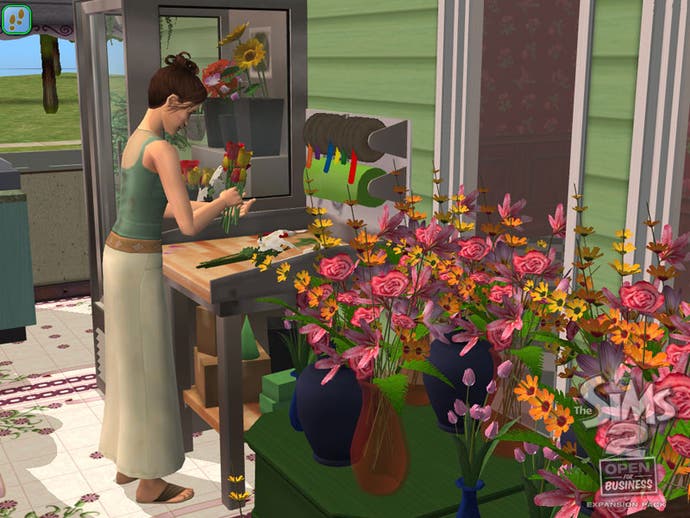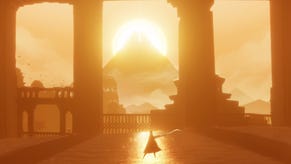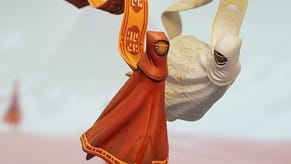Robin Hunicke's extraordinary journey
From Spielberg's postman to discovering Katamari, Journey's lead designer's wild voyage of discovery.
For one summer in the mid-2000s, a not insignificant portion of the game designer Robin Hunicke's day involved placing a Nintendo Wii disc into an envelope and posting it to Stephen Spielberg's boat. Spielberg was on holiday at the time, taking a break with his family from sweltering Los Angeles and production work on the film adaptation of Herge's TinTin. There was no time to break from Hunicke's game BoomBlox, however, whose deadline was approaching. Besides, Spielberg's original idea for the game - a kind of anti-Jenga involving knocking down towers of blocks - came about because he wanted a non-violent game to play with his children. He was happy to receive builds through the mail while on holiday, where his kids could pitch in with the feedback.
Hunicke's path to this moment was unorthodox and unexpected. She grew up near the mountains in Saratoga Springs, New York, close to Vermont. Her mother taught maths and weaved. Her father was a nuclear engineer. They lived on a street alongside 20 or so other families, all with children of similar ages. In the summer Hunicke and her friends would build forts in the forest, and race twig boats in the frothing river. In the winter there were board-games and NES. It was a playful, often idyllic childhood, she recalls. Each summer during high school, Hunicke would be sent to art camp, where she'd paint and build.
One year Hunicke and her father built a grandfather clock. It had been, rather befittingly, her grandfather's project originally. He built the base from African red hardwood then, upon realising the scale of the job, shipped the materials to his son and granddaughter to finish. Hunicke's father ordered the clock mechanism from Germany. The finished clock still lives at her father's house. Every time she returns home she listen to the rounded tock of the mechanism. "It fills me with joy," she says. "I love the experience of seeing something you've made come to life."

Video games were a natural fit for Hunicke's nascent interests, combining her mathematical talent ("At night, when I couldn't get to sleep, I'd count the leaves on a branch out side of my bedroom window," she recalls. "I'd multiply that by the number of branches I estimated the tree to have, and that figure by the number of trees in our yard, then our road, then our town, then our State") and her artistic sensibilities. But she has a magpie temperament. "I was interested in everything", she says. "So when I went to college I made up my major, a combination of fine art, film studies, women's studies and computer science." While at the University of Chicago Hunicke's aptitude for computers earned her a job at a police station where she would schedule the officers on a database system. "I soon discovered that was less fun than working on the computer lab at college so I got a new job managing the Mac lab there." As Hunicke learned more and more computer languages her focus narrowed. She began studying for a doctorate in artificial intelligence.
Video games had, up to this point, played only a supporting role in Hunicke's life. Her first love was M.U.L.E., the Commodore 64 game in which players compete against each other and the computer in a bid for survival, which she'd play at a friend's house when she was 12. "I loved trying to outwit each other and the game at the same time," she recalls. It was only when Hunicke started her PhD in AI, and became interested in adaptive difficulty in video games, specifically Half-Life, that she began hanging out with game-makers.
During a visit to the Game Developer's Conference, where she hoped to interview AI programmers for her doctorate, Hunicke was offered a job by EA to work on The Sims. "I thought I'd become a professor in AI and robotics," she says. "But I started working on The Sims 2 six months before I got my doctorate. I thought I'd just go to work and then finish my PhD alongside it. I didn't realise how hard devs work."
While women had been in the minority on her computer science course, when she joined The Sims team, there was a 50/50 gender split. "They had done a fantastic job recruiting from their community, and because the game's audience was so diverse, that had filtered up into the team." The diversity is down, she says, to two simple factors: marketing and game design. "The Sims was advertised to everyone," she says. "If a game is made to appeal to a broad audience, and can accommodate a broad selection of player interests, then some of those people will inevitably want to work on it and games like it. You can see the same thing at Blizzard because World of Warcraft and Overwatch."
Hunicke had to learn on the job. Her team was working on the 'Open For Business' expansion pack, which allows players to start-up business ventures to earn money for their Sims. Hunicke's team designed a flower shop, which allowed players to craft flower arrangements and then sell the bouquets. "It was good design training. You could teach yourself about the game and its various systems just by working on narrow objects," she says. The in-game businesses had to have fail states, for example. "Our failure state was that the flowers emitted gas that made the Sims just freak out. It was the opposite of a Zen meditation: depressing flowers."
After completing her work on The Sims 2, rather than finish her doctorate, Hunicke took a promotion to become lead designer on MySims. Then, after 18 months, she joined Spielberg's BoomBlox team. While she loved her time working with Spielberg ("He always made time for us, which you would expect to not be the case.") Hunicke was now in her mid-30s and feeling adrift. She decided to book a holiday. Her choice of destination reflected her mental state or, perhaps, that of her subconscious: a 16,500 foot-high mountain in Bhutan.
"I needed a break," she says. Perhaps, but the peak she faced in Bhutan mirrored other towering questions in her life. Was she going to stay in Los Angeles? Was she going to stay in her current relationship? Was she going to continue making games? While ascending the mountain Hunicke met other English-speaking climbers who were also taking a step back to examine their goals and challenges. "It made me realise we are all on a similar journey," she says. "That helped me with imposter syndrome." As she came over the top of the mountain, a burden lifted, she says. Then, when she arrived in Los Angeles, she received a message from an old friend, Jenova Chen: would she like to be lead designer on his new project, a game about a pilgrimage to a mountain where, en route, you meet people who fleetingly join you. "It felt right," she says.
When Hunicke joined thatgamecompany she was the sixth employee. The team was working from a "closet-sized room" and had just completed a prototype of the game, which would later be named Journey, in Flash, in which players were represented as coloured dots. "I supervised the first four player playtest," Hunicke recalls. "We brought people in through different doors so nobody knew it was a multiplayer game. Then we brought them together to discuss what they'd seen. These were just coloured dots that could only move or, if the player hit the space bar, say 'hey!', but people immediately would project emotions and personalities onto the dots they were playing with, calling them the 'mean' one, or the 'helpful' one. That's when I knew the idea was special."

Following Journey's tremendous success, much of the team dispersed. Hunicke reconnected with another designer friend of hers, Keita Takahashi, whom she had met while at grad school. At the time she'd read about Takahashi's forthcoming game, Katamari Damacy. Such was her desperation to play the game that she booked a flight to the Tokyo Game Show. "I managed to get Keita's card while I was there," she recalls. After she returned to the US, Hunicke booked Takahashi to come to GDC and demonstrate Katamari at the Experimental Gameplay Workshop, where every year a clutch of designers show off ground-breaking ideas to a packed auditorium of peers. "Because of the press reaction to that, Namco brought the game over into English," she says. "I am his number one fan."
Takashi and Hunicke make for a harmonious paring. Both designers have a background in arts and crafts and Hunicke's new studio Funomena, founded in 2012 with her former colleague Martin Middleton, is filled with sand, clay, pipe-cleaners, wire toys and so on. "We often model stuff by hand before putting them in our games," she says. Funomena is currently working on three games, one of which, Wattam, is being directed by Takahashi. Wattam, for which a release date has not yet been announced, reflects the foundations of Hunicke's childhood: playfulness, creativity, collaboration. "Keita's view on childhood and play is similar to mine," she says. "People should make things. We want this game to be more about you as a player than about us as the designers, artists and musicians behind it."
Games that encourage this kind of playfulness rather than than seek to force a specific message are at the core of Hunicke's interest. While she holds up Papers, Please and Cart Life as prime examples of what games can achieve she wants her work to have looser interpretations. "I know people who make films who feel their film has a single interpretation," she says. "But they are rare. The majority of people who write or make films and art are just trying to get something out of them. When it's in the world it's there for everybody to draw what they will from the work. Besides, you can't control the context. For example, art that's made in this moment around Brexit could have a very different interpretation in ten years depending on what happens to Britain's fortunes."
For today's context with its climate of fear and uncertainty, of strongmen on the rise, of nations baring teeth, playfulness is, Hunicke believes, a necessity. "We've been spending a lot of time thinking about mechanics and systems as an industry," he says. "Doing something a little more open is important right now for this difficult, sad and important time. We're having conversations about all of the forces that inform how we behave, and how we sustain our planet. They are crucial conversations. But that needs the counterbalance of playfulness. All of the games I'm working on at the moment are about interacting with others in purely playful ways. I hope they encourage people to help one another, not for what they can get out of it, but just for the sake of it."










